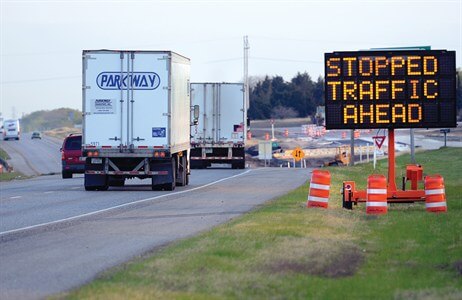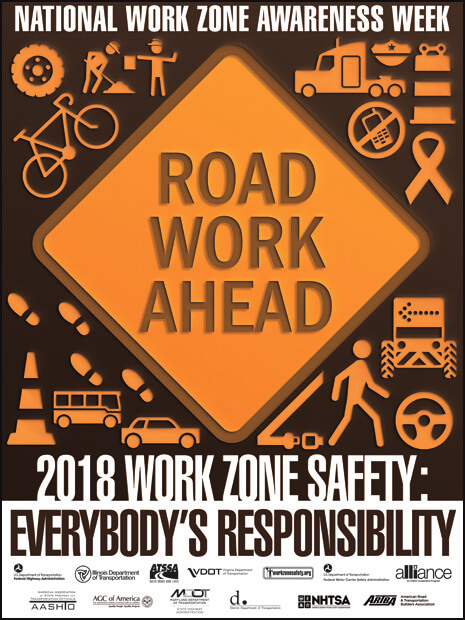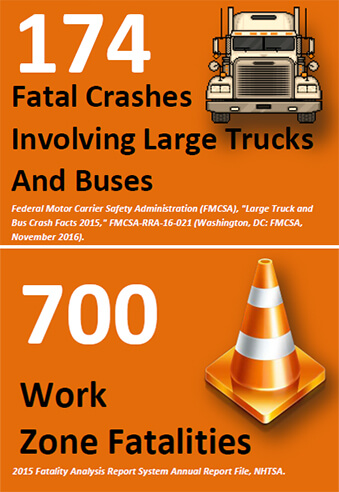NJLTAP Enews Volume 20, Issue 2 – March/April 2018
According to the Fatal Accident Reporting System (FARS) over 130 fatal crashes involving commercial vehicles occur in work zones, accounting for about one-fourth of all fatal accidents in these locations nationally.
This astounding percentage equates to a fatal accident occurring every 3 days involving a commercial vehicle in a work zone. Place that work zone on a rural interstate roadway during the daytime and that percentage of fatal accidents in work zones involving large trucks increases to above 50 percent. Comparatively, large trucks are involved in 9 to 12 percent of fatal crashes outside of work zones.
It is no secret what the types of accidents commercial vehicles in work zones are most overrepresented in; rear-end collisions upstream. However, depending on the type of roadway, large trucks also are overrepresented in sideswipes on high-speed, controlled-access roadways. On multi-lane roadways, not only are trucks overrepresented on aforementioned sideswipes, but also on angled crashes and single-vehicle object impact collisions. Lastly, on two-lane, two-way highways, large trucks are overrepresented in rear-end collisions and during nighttime hours, head-on collisions.
The common-sense answer has to do with the size and weight of these vehicles. Heavier vehicles require longer stopping distances to dissipate their kinetic energy. Unfortunately, when these distances are shortened or are nonexistent, crash severity naturally increases. Also, CMVs have a higher center of gravity which increases their chance of losing control, particularly when work zones often require a lane change or a shift in lanes to accommodate the work being conducted. Furthermore, large trucks have larger blind spots which increase the difficulty in observing smaller vehicles when attempting to change lanes at a merge taper. Finally, the distance is greater between a commercial driver’s eyes and the headlights of their vehicles, reducing their ability to observe the brightness and retro-reflectivity of signs and vehicles in front of them.
According to Texas A&M Transportation Institute’s research, there are two main categories to reduce the over representation of truck crashes in work zones:
Work Zone Design
- Consider effects of CMVs upon capacity and operations when conducting a work zone impact analysis
- Provide 11-foot lanes plus 1-foot buffer if barrier is used
- Encourage alternate routes and detours for large trucks
- Consider a “truck only” lane through the work zone and detour automobiles
- Minimize speed reductions in critical geometric features in the work zone
- Avoid using rest stops for trucks as staging areas for construction equipment
- Use high performance sheeting on signs and channelization devices particularly if deployed at night for great visibility
- Consider using a MASH tested Level 3 crash attenuation device
- When narrower lane widths are needed, consider maintaining a 12-foot width for trucks and reducing the other lanes for cars
- Minimize capacity reductions that will create queues
- If queues are unavoidable, consider placing the lane closure further upstream to maximize site distance from the anticipated back of the queue in relation to the geometry of the roadway
- Utilize queue warning systems that employ work zone intelligent transportation systems (ITS)
- Portable rumble strips upstream to gain motorist attention
- Consider closing entrance ramps if sufficient acceleration lane lengths cannot be maintained
Educating Truck Drivers
- Encourage CMV operators to activate emergency flashers whenever stopped or slowing down in a work zone
- Provide outreach information to the CMV industry educating them about the dangers inherent in work zones
Unfortunately, when trucks are involved in crashes the outcomes can be devastating. Therefore, educating, planning, and employing various safety countermeasures that take into consideration the size and weight of large trucks operating in and around the work zone can and will reduce the disproportionate amount of work zones crashes, ultimately saving more lives.
This newsletter is published biannually by the New Jersey Local Technical Assistance Program, Center for Advanced Infrastructure and Transportation, Rutgers University, using funds from the Federal Highway Administration and the New Jersey Department of Transportation. The opinions, findings, or recommendations expressed in this newsletter are those of the New Jersey Local Technical Assistance Program and do not necessarily reflect the views of the Federal Highway Administration nor the New Jersey Department of Transportation nor Rutgers University. Any product mentioned in this newsletter is for information purposes only and should not be considered a product endorsement.




